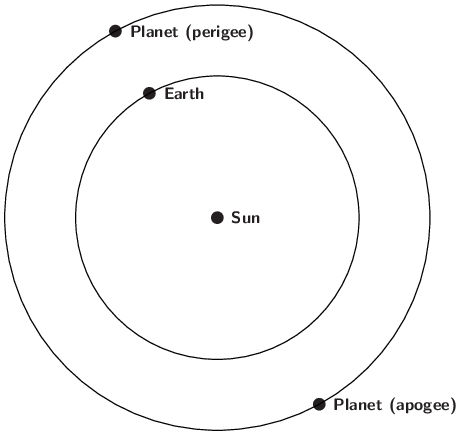136472 Makemake will reach opposition, when it lies opposite to the Sun in the sky. Lying in the constellation Leo Minor, it will be visible for much of the night, reaching its highest point in the sky around midnight local time.
From South El Monte, it will be visible in the morning sky, becoming accessible around 18:37, when it reaches an altitude of 21° above your north-eastern horizon. It will then reach its highest point in the sky at 00:31, 84° above your northern horizon. It will be lost to dawn twilight around 05:26, 32° above your north-western horizon.
A close approach to the Earth
At around the same time that 136472 Makemake passes opposition, it also makes its closest approach to the Earth – termed its perigee – making it appear at its brightest.
This happens because when 136472 Makemake lies opposite to the Sun in the sky, the Earth passes between 136472 Makemake and the Sun. The solar system is lined up with 136472 Makemake and the Earth on the same side of the Sun, as shown by the configuration labelled perigee in the diagram below:

When a planet is at opposition, the solar system is aligned such that the planet
lies on the same side of the Sun as the Earth. At this time, the planet makes its
perigee, or closest approach to the Earth.
Not drawn to scale.
In practice, however, 136472 Makemake orbits much further out in the solar system than the Earth – at an average distance from the Sun of 45.42 times that of the Earth, and so its brightness does not vary much as it cycles between opposition and solar conjunction.
Observing 136472 Makemake
At opposition, 136472 Makemake is visible for much of the night. When it lies opposite to the Sun in the sky, this means that it rises at around the time the Sun sets, and it sets at around the time the Sun rises. It reaches its highest point in the sky at around midnight local time.
But even when it is at its closest point to the Earth, 136472 Makemake is so distant from the Earth that it is not possible to distinguish it as more than a star-like point of light, even through a telescope.
A chart of the path of 136472 Makemake across the sky in 2281 can be found here, and a chart of its rising and setting times here.
At the moment of opposition, 136472 Makemake will lie at a distance of 48.00 AU, and reach a peak brightness of magnitude 16.7. Its celestial coordinates at the moment it passes opposition will be:
| Object | Right Ascension | Declination | Constellation | Magnitude | Angular Size |
| 136472 Makemake | 10h05m50s | 39°41'N | Leo Minor | 16.7 | 0.0" |
The coordinates above are given in J2000.0.
Over the weeks following its opposition, 136472 Makemake will reach its highest point in the sky four minutes earlier each night, gradually receding from the pre-dawn morning sky while remaining visible in the evening sky for a few months.
The sky on 24 Oct 2025
| The sky on 24 October 2025 | ||||||||||||||||||||||||||||||||||
|
10% 3 days old |
All times shown in PDT.
|
|||||||||||||||||||||||||||||||||
Source
The circumstances of this event were computed using the DE430 planetary ephemeris published by the Jet Propulsion Laboratory (JPL).
This event was automatically generated by searching the ephemeris for planetary alignments which are of interest to amateur astronomers, and the text above was generated based on an estimate of your location.
Related news
| 11 Feb 2281 | – 136472 Makemake at opposition |
| 12 Feb 2282 | – 136472 Makemake at opposition |
| 13 Feb 2283 | – 136472 Makemake at opposition |
| 15 Feb 2284 | – 136472 Makemake at opposition |
Image credit
© NASA/Hubble Space Telescope


